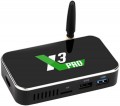Bluetooth
Bluetooth is a technology used to connect various devices wirelessly directly. In media centers and TV receivers, it can be used to broadcast sound to wireless headphones and acoustics, to work with wireless mice and keyboards, to use a smartphone / tablet as a remote control, etc.; specific functionality should be specified separately. Also note that the supported version of Bluetooth can be specified here. The newest and most advanced is
Bluetooth 5.0, but here is a more detailed description of the different versions:
- Bluetooth v4.0. The version in which the "Bluetooth Low Energy" (LE) format was first introduced — in addition to regular Bluetooth (version 2.1 functionality) and the high-speed HE standard for transferring large amounts of information (introduced in version 3.0). Bluetooth LE allows you to significantly reduce power consumption when transmitting small data packets, such as request-responses about connection activity in idle mode. For the media centers and TV receivers themselves, this is not particularly important, but for portable equipment (especially miniature ones, where battery capacity is very limited), such functionality will be useful.
- Bluetooth v 4.1. Development and improvement of Bluetooth 4.0. One of the key improvements was the optimization of collaboration with 4G LTE communication modules so that Bluetooth and LTE do not interfere with each other. In addition, this ve...rsion has the ability to simultaneously use a Bluetooth device in several roles — for example, to remotely control an external device while simultaneously streaming music to headphones.
- Bluetooth v4.2. Further, after 4.1, the development of the Bluetooth standard. It did not introduce fundamental updates, but received a number of improvements regarding reliability and noise immunity, as well as improved compatibility with the Internet of Things.
- Bluetooth v5.0. Version introduced in 2016. One of the most notable updates was the introduction of two new modes of operation for Bluetooth LE — with an increase in speed by reducing the range and with an increase in range by reducing the speed. In addition, a number of improvements have been introduced regarding simultaneous work with numerous connected devices, as well as work with the components of the Internet of Things.
Wi-Fi
Wi-Fi is a technology used for wireless connection to computer networks and for direct connection between devices. In media players, tuners and video capture devices, it can be used both to access the Internet or "local area" through a wireless router, and to communicate with a smartphone, tablet, etc. The
AirPlay, Chromecast and Miracast functions are also based on this technology. The specific set of Wi-Fi features should be clarified separately; here we note that in this paragraph the specific supported version of such a connection can also be specified. Here are the main current options:
- Wi-Fi 5(802.11ac). One of the newest (for 2020) standards. Uses the 5 GHz band (less crowded than used in earlier 2.4 GHz versions) for improved reliability and lower latency; and speeds can reach 6.77 Gbps with multiple antennas and 1.69 Gbps with a single antenna.
- Wi-Fi 4 (802.11n). The predecessor of the above Wi-Fi 5, the first standard in which the 5 GHz band was introduced — here it is used along with the traditional 2.4 GHz and is not supported by some devices with Wi-Fi 4. Data transfer rate — up to 600 Mbps.
Note that, in addition to the directly claimed Wi-Fi standard, the media centre, digital receivers and video capture devices usually provide support for earlier versions — for maximum compatibility with different devices.
AV output
—
AV output. Analogue output for video and audio transferring. Previously, due to the large size of the equipment, it consisted of 3 RCA jacks and was connected to the TV accordingly. Now the devices have become more compact and don't have free space on the case. Therefore, the AV output is a single headphone jack, to which a tee cable is already connected (check availability in the package). Since all components of the video signal are on the same cable, the picture quality and immunity to interference are low.
CPU
The model of the CPU installed in the media player.
This information is mainly of reference value: the processor is selected in such a way as to provide certain practical characteristics (maximum resolution, support for certain standards, embedded applications, etc.). So when choosing, you should focus primarily on these specifications. However, if you wish, knowing the processor model, you can find detailed data on it and evaluate the capabilities of the media centre to work with resource-consuming applications. This can be useful, in particular, if you choose an Android model (see above) and plan to use additional software intensively — the set of applications for this OS is very extensive, and some of them are quite demanding on system resources.
Also note that CPU data is often specified for advertising purposes — to emphasize that the device has a fairly advanced chip from a well-known brand. Among the most common brands of such processors are
Allwinner,
Amlogic,
Rockchip,
Realtek.
CPU cores
The core is the part of the processor that executes a single thread of instructions. Accordingly, the presence of multiple cores allows to work with multiple threads simultaneously, which has a positive effect on performance. Theoretically, more cores (
4 cores or even
6 cores or more) can increase the efficiency of the processor. However, in fact, CPU performance depends on so many additional factors that the number of cores is purely a reference parameter. So, a high-end dual-core processor may well be more performant than an inexpensive quad-core one.

